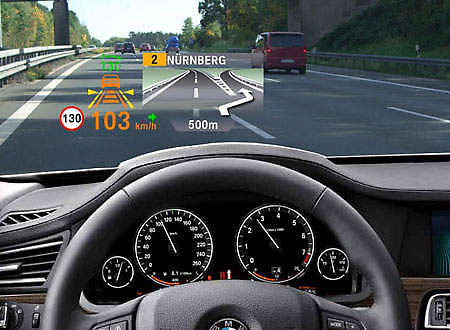If you still
find yourself struggling to grasp the concept of "adding an additional layer to reality," let us help you by giving a couple of practical applications of this
technology - in the fighter cockpit and in a BMW.
In short, augmented reality is used to project images onto windshields.
As most
advances in cutting-edge technology have their origin in the armaments
industry, we can find a few early-stage implementations of AR in high-tech
weaponry.
Let's start
with helmet-mounted displays (HMD) for pilots. HMD's are a device used in
combat aircraft. It appeared in the mid-1970s to help the pilot aim heat
seeking missiles or make bore attacks by projecting important targeting and
navigational information onto the goggles of aviator. Its effectiveness was shown after the South African Air Force's first jet fighter operations with HMD, and many nations have adopted this technology.


The IHADSS is integrated with the sensors of the combat helicopter. These sensors are calibrated and aligned so that the line of sight (LOS) of the aviator is directed to the targeting points of missiles and machine guns, making it easier for the pilot to aim. In order to detect movement of the pilot's head and helmet, optical and electromagnetic tracking technologies are used.

Although it
looks magical, it is also very simple in concept. The images are projected through a small square depression on the dashboard.
These two are clear uses of AR in real life. Nevertheless, AR is not widely
spread nor perceived as a technology anywhere close to maturity. Below is Gartner's technology hype cycle for 2012. According to Gartner (an IT research and advisory firm in the US that coined the term), "A hype cycle is a
graphic representation of the maturity, adoption and social application of
specific technologies.” Gartner has been using this hype
cycle to explain the over-enthusiasm or 'hype' and subsequent disappointment
that typically happens with the introduction of new technologies.1)
According to the hype cycle, AR is is just barely past the ‘Peak of Inflated Expectations,' which means there is a chance that the expectations or enthusiasm for this technology is overly inflated. Gartner also estimated that it will take 2 to 5 years for the benefits of AR become widely demonstrated and accepted.
But
recently we have seen a fascinating video of one product which is the first huge
push to get useful AR into the hands of everyone. It is Google Glass, and it has a huge amount of hype behind it! Please take 2 minutes of your time to watch this video.
[Google glasses official promo: http://youtu.be/6BTCoT8ajbI]
We
will later study and share more about this potentially revolutionary technology from Google. But we
discovered there is much more than Google Glass to be excited about! Let us steal a peek even further into the future of AR.
First, beyond glasses with AR, some scientists are
developing AR contact lenses! These virtual contact lenses will
eventually replace glasses in the future. At the university of Washington,
professor Babak Amir Parviz and his students are working on it, and it may become a reality soon enough.2)


Second,
even more than virtual contact lenses, some scientists are trying to implant a transceiver
into the human body which receives electric video signal from the outside and transmits signals directly to the eye tissue. This is called the Argus-II bionic eye. It's not so far fetched as you might think - the US FDA approved the world’s first bionic eye recently.
Lastly,
let us tell you another interesting application of AR - Aurasma. It is a software tool that adds animated video layers onto the real view of the smartphone, as apposed to other apps that only display static images and text. You can tag any kind of real world image and link that with video. Once the smartphone identifies the tag of the real image, it automatically adds a video layer. Please take a look at Matt Mills' TED speech about this software.
[Matt Mills at TED: http://youtu.be/frrZbq2LpwI]
Aurasma is a free app, which can be used on most iPhones and Android devices. By installing the app pointing your phone at a tangible real world object (such as a building, movie poster, or newspaper), a user is instantly presented with one or more layers of rich media content such as sound, video, or animation.3)
Aurasma shows another possibility of practical implementation of AR - effectively delivering complex information in an easy to understand manner. HP (owner of Autonomy, which developed Aurasma) expects Aurasma will soon replace traditional paper user manuals. By just pointing your smartphone at the new device you bought from HP, you can watch animated guideline for installation and use. Aurasma also has huge implications for educational use.
As you may have noticed, the pace of AR development is growing rapidly and the impact of this technology on human life is boggles the imagination. As a first start, we truly hope Google Glass does not fizzle out, but introduces the world the possibilities of AR.
We hope you enjoyed our second journey into AR. See you at the next post!!!
- Team Ogres -
[References]
1) Quoted from
Wikipedia 'hype cycle'
2) Reference from web site ‘Bit Rebels’
(http://www.bitrebels.com/)
3) "Making augmented reality a reality can benefit insurers" by Barry Rabkin, OVUM (http://ovum.com/2012/03/27/making-augmented-reality-a-reality-can-benefit-insurers/)

Isn't the name of the company 'Autonomy' familiar? Guess it!!! : )
ReplyDelete